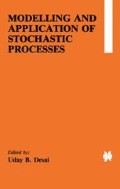Abstract
This chapter deals with the problem of constructing a state-space model for a stochastic process from a finite number of estimated covariance lags. The approach is to first obtain a high-order model which exactly matches the estimated covariance sequence, and then use balanced model reduction techniques to obtain a lower order model which approximates the given sequence. It is shown that balanced models can be obtained from a realization algorithm which uses an infinite covariance sequence. Scaling ideas are then introduced so that balanced realizations can be obtained from finite covariance sequences.
Access this chapter
Tax calculation will be finalised at checkout
Purchases are for personal use only
Preview
Unable to display preview. Download preview PDF.
References
P. Faurre, In: System Identification: Advances and Case Studies (Eds. R.K. Mehra and D.G. Lainiotis), Academic Press, New York, 1976, pp. 1–25.
R.J. Vaccaro and B.W. Dickinson, In:Proc. 19th Annual Asilomar Conf., Pacific Grove, CA, November, 1985.
M. Gevers and W.R.E Wouters, Journal A vol. 19, pp. 90–110, 1978.
B.D.O. Anderson and J.B. Moore, Optimal Filtering, Prentice-Hall, Englewood- Cliffs, 1979.
H. Akaike, IEEE Trans. Automat. Contr. vol. AC-19, pp. 667–674, 1974.
B.L. Ho and R.E. Kaiman, In: Proc. 3rd Aller ton ConfMonticello, Illinois, pp.449- 459, 1965.
J. Rissanen, SIAM J. Contr. vol. 9, pp. 420–430, 1971.
R.E. Kaiman, In: Acta Polytechnica Scandinavica, Mathematics and Computer Science Series No. 31, pp. 9–32, 1979.
B.C. MooreIEEE Trans. Automat. Contr., vol. AC-26, pp. 17–32, 1981.
L. Pernebo and L.M. Silverman, IEEE Trans. Automat. Contr. vol. AC-27, pp. 382–387, 1982.
R.J. Vaccaro, Ph.D. Dissertation, Princeton University, Princeton, NJ, 1983.
K.V. Fernando and H. Nicholson, IEEE Trans. Automat. Contr. vol. AC-28, pp. 228–231, 1983.
V.C. Klema and A.J. LaubIEEE Trans. Automat. Contr. vol. AC-25, pp. 164–176, 1980.
K.S. Arun, D.V. Bhaskar Rao, and S.Y. Kung, In:Proc. 22nd IEEE Conf. Decision Contr. San Antonio, TX, pp. 1353–1355, 1983.
K.S. Arun and S.Y. Kung, In: Proc. IEEE Spectral Estimation Workshop II pp. 161–167, 1983.
S. Fujishige, S. Nagai, and Y. Sawaragi, Int. J. Contr. vol. 22, pp. 807–819, 1975.
R.J. Vaccaro, IEEE Trans. Automat. Contr. vol. AC-30, pp. 921–923, 1985.
A.J. Laub, In: Proc. 1980 JACC FA8-E, 1980.
U.B. Desai and D. Pal, In:Proc. 16th Annual Conf. Inform. Sei., Syst. Princeton Univ., Princeton, NJ, 1982; also in Proc. 22nd IEEE Conf. Decision, Contr. Orlando, FL, 1982.
U.B. Desai and D. Pal, IEEE Trans. Automat. Contr. vol. AC-29, pp. 1097–1100, 1984.
J.A. Ramos and E.I. Verriest, In: Proc. American Contr. Conf. San Diego, CA, pp. 150–155, 1984.
C.I. Byrnes and A. Lindquist, Syst. Contr. Letters vol. 2, pp. 99–105, 1982. 23
R.J. Vaccaro, IEEE Proceedings (Letters) to appear, 1986.
Y. Baram, IEEE Trans. Automat. Contr. vol. AC-26, pp. 1225–1231, 1981.
G.H. Golub, V.C. Klema, and G.W. Stewart, Stanford Univ. Tech. Rep. STAN-CS-76-559, Computer Sei. Dept., Stanford Univ., Palo Alto, CA, 1976.
H.P. Zeiger and A.J. McEwenIEEE Trans. Automat. Contr. p. 153, 1974.
S.Y. Kung, In: Proc. 12th Asilomar Conf. Pacific Grove, CA, pp. 705–714, 1978.
Author information
Authors and Affiliations
Editor information
Editors and Affiliations
Rights and permissions
Copyright information
© 1986 Kluwer Academic Publishers, Boston
About this chapter
Cite this chapter
Vaccaro, R.J. (1986). Finite-Data Algorithms for Approximate Stochastic Realization. In: Desai, U.B. (eds) Modelling and Application of Stochastic Processes. Springer, Boston, MA. https://doi.org/10.1007/978-1-4613-2267-2_5
Download citation
DOI: https://doi.org/10.1007/978-1-4613-2267-2_5
Publisher Name: Springer, Boston, MA
Print ISBN: 978-1-4612-9400-9
Online ISBN: 978-1-4613-2267-2
eBook Packages: Springer Book Archive

